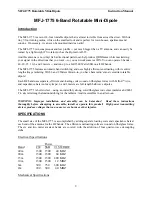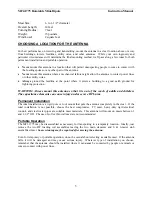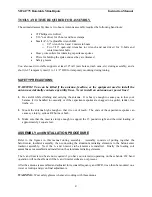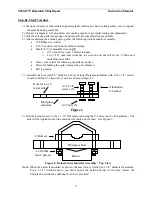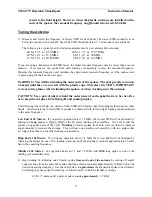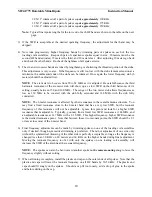
MFJ-1775 Rotatable Mini-Dipole
Instruction Manual
8
16) Loosen the mounting screw indicated in Figure 5 so that the aluminum radiator can be slid under the
aluminum tab. Slide the aluminum radiator tube until it contacts the mounting screw that was just
loosened. Tighten the mounting screw.
Do not over-tighten this screw or you may BREAK the
fiberglass form.
Slide the last hose clamp over the tab and tighten the hose clamp to firmly attach
the loading assembly to the aluminum radiator.
17) Double check the tightness of all the hardware you installed and then mount the antenna on the short
temporary tuning mast 6-8 feet above the ground.
18) Tune the antenna as discussed in the next section.
19) Mount the antenna in the final location. Slight re-tuning may be necessary.
FREQUENCY AND SWR ADJUSTMENT
An SWR analyzer such as the MFJ-259B or equivalent is highly recommended when tuning the MFJ-
1775. While a transceiver and SWR meter can be used, an SWR analyzer will significantly decrease the
time and effort necessary to tune the antenna.
The MFJ-1775 covers wider frequency ranges on the higher bands, and narrower segments on the lower
frequency bands. The 40 meter band has the narrowest range of operation (approximately 40 KHz) and is
the most sensitive to adjustments.
The entire antenna must be accessible during initial coarse tuning and testing. Any repair or adjustment
to the antenna after it is installed on a tall support will make adjustments difficult and time consuming. It
is best to install the antenna on a short temporary mast or pipe that is located in a reasonably clear
location for tuning. The antenna should be mounted horizontally 6-8 feet above ground to make tests and
adjustments easy.
During tuning, feed the antenna with a reasonably short length of good quality 50 ohm coaxial cable to
ensure proper results. If using a transceiver and SWR meter, set the transceiver to the lowest power
possible when making measurements.
The normal resonant frequency of this antenna is at or just below the bottom of each amateur
band.
This allows the user to "trim" a small amount off the capacitance spokes to raise the resonant
frequency. Conversely, adding a longer capacitance spoke will lower the resonant frequency of a loading
assembly. Spare spokes are included in case you need to lower the resonant frequency of the antenna.
CAUTION
:
Always start tuning on 40 meters and adjust each band progressively higher in
frequency
. Adjustment of a lower frequency band will always have the most effect on the next higher
frequency band. The tendency of the interaction is that if you move one band higher ALL the other bands
move higher, but only very slightly. It is always best to "shoot for" the lowest end of the range you
intend to use and "trim in" by adjusting the outermost (40 meter) loading coil assemblies after the antenna
is in its final location.
NOTE: When you tune the antenna at a height of 6-8 feet, you will find that the resonant
40 meter frequency will shift up in frequency 30-50 kHz when the antenna is


